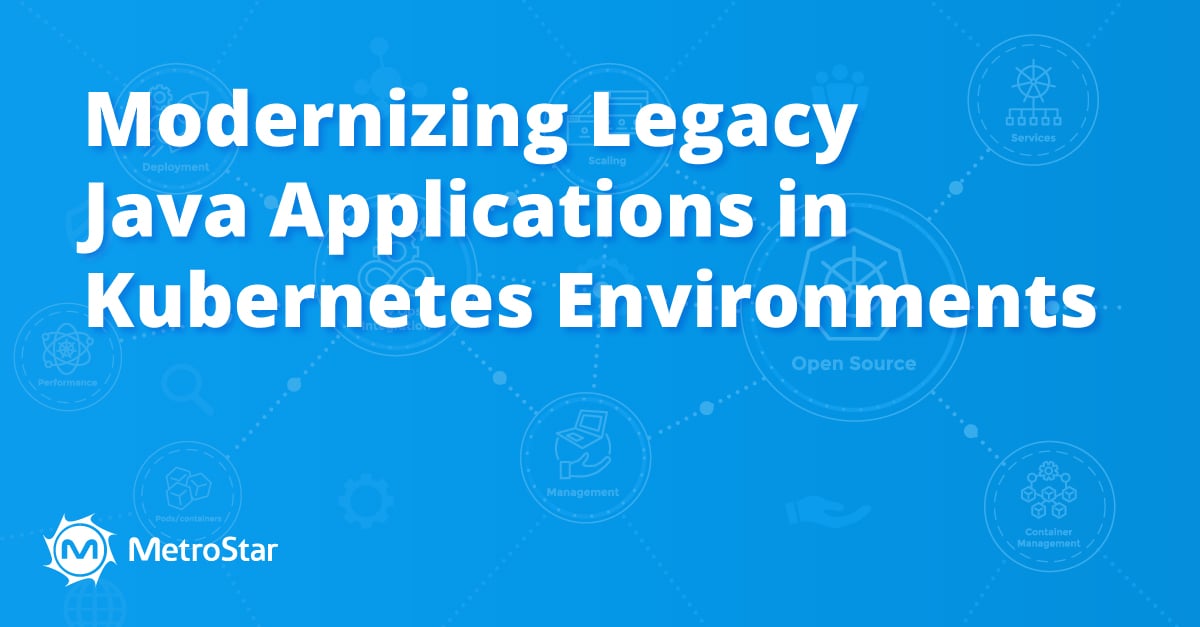Modernizing Legacy Java Applications in Kubernetes Environments
4 MIN READ
05/14/2024 | Enterprise IT | Feature

Legacy Java applications, while proven and stable, often need help to compete in today's dynamic cloud landscapes. Their monolithic architecture can hinder agility, scalability, and efficient resource utilization. Fortunately, Kubernetes, the container orchestration platform, offers a compelling solution to modernize these applications and unlock new capabilities. This blog post explores methods and considerations of modernizing legacy Java applications in Kubernetes environments and outlines important factors when starting new Spring Boot projects.
Two Primary Migration Approaches
There are two primary approaches to consider when migrating legacy Java applications to Kubernetes environments:
-
Strangler Pattern: This incremental approach involves gradually refactoring the legacy application into microservices. Spring Boot components can be introduced alongside the existing application, slowly strangling out the legacy functionalities. This approach minimizes risk and allows for a controlled migration process. The strangler pattern creates a facade or "wrapper" service around the monolithic application. This facade service intercepts incoming requests and routes them to the appropriate backend service, a new Spring Boot microservice, or the original legacy code. Over time, you can gradually migrate more functionalities to Spring Boot microservices, eventually phasing out the legacy application entirely.
-
Big Bang Rewrite: This more aggressive approach involves completely rewriting the legacy application as a microservices architecture using Spring Boot. While this can be faster, it carries a higher risk of introducing errors or unforeseen issues and requires more upfront investment than the strangler pattern.
Key Considerations for Spring Boot Setup
Spring Boot is a popular framework for building Java applications and containerized microservices. Here's a list of essential considerations when adopting the Spring Boot framework for your microservices:
-
Spring Initializr: This web-based tool helps you quickly generate a basic Spring Boot project with the necessary dependencies. You can specify the desired features (e.g., Web, Data JPA), Java version, and packaging format (e.g., JAR) to get a project template tailored to your application's requirements.
-
Entrypoint: Develop a Spring Boot application class with an @SpringBootApplication annotation as the main entry point.
-
Auto-configuration: Utilize Spring Boot's auto-configuration features to simplify setup for tasks such as database access and web server configuration. You need to opt-in to auto-configuration by adding the @EnableAutoConfiguration or @SpringBootApplication annotations to one of your @Configuration classes.
-
Components and Services: Refactor legacy code following the Controller-Service-Repository pattern by annotating Spring components with @Service, @Controller, and @Repository for efficient dependency injection and lifecycle management.
-
Configuration Management: Transition from ugly XML configuration files to Spring Boot's property-based configuration or environment variables using Spring Profiles.
Configuring Spring Boot for Containers
Adapting Java Spring Boot applications for containerized environments requires subtle approaches:
-
Environment Variables: Rely on environment variables for configuration instead of property files.
-
Spring Profiles: Activate different configurations based on the environment using Spring Profiles.
-
Externalized Configuration: For complex configurations, utilize external configuration sources like Spring Cloud Config or key-value stores (e.g., etcd, consul).
-
Cloud Native Buildpacks / Dockerfiles: Use buildpacks or Dockerfiles for streamlined container builds.
-
Entrypoint Script: Define custom entrypoint scripts for pre-processing tasks.
Key Considerations for Kubernetes Setup
Deploying Java Spring Boot applications in Kubernetes environments requires careful consideration of several technical aspects:
Containerization
-
Base Image: Opt for lightweight Linux distributions to minimize image size and improve startup time.
-
Multi-stage Builds: Employ multi-stage builds to optimize image size and separate build and runtime environments.
-
Java Version: Ensure usage of supported and secure Java versions like Java 17 or 11 LTS.
Configuration Management
-
Environment Variables: Store application configurations in environment variables for seamless management within Kubernetes deployments.
-
Secrets Management: Safely store sensitive information using Kubernetes Secrets.
-
ConfigMaps: Utilize ConfigMaps to share configuration data across multiple pods.
Deployment and Scaling
-
Liveness and Readiness Probes: Define probes to ensure pod health and control application lifecycle.
-
Resource Requests and Limits: Specify resource requirements to control CPU and memory usage.
-
Horizontal Pod Autoscaler (HPA): Implement automatic scaling based on predefined metrics.
Monitoring and Logging
-
Spring Actuator: Utilize Actuator endpoints for health checks and application metrics.
-
Integration with Monitoring Tools: Integrate applications with monitoring tools like Prometheus and Grafana.
-
Logging Strategy: Define logging strategies for effective log collection and management.
Security
-
RBAC: Implement Role-Based Access Control for proper authorization.
-
Network Policies: Enforce security boundaries using Network Policies.
-
Vulnerability Scanning: Regularly scan container images for vulnerabilities.
Modernizing legacy Java applications within Kubernetes environments presents challenges and opportunities for technical experts. By adopting best practices in containerization, configuration management, deployment, and migration strategies, organizations can unlock their applications' full potential, driving innovation and competitiveness in today's digital landscape. Embrace the transformative power of Kubernetes and Spring Boot to propel your legacy applications into the future of cloud-native computing.
References
-
Strangler Pattern: https://learn.microsoft.com/en-us/azure/architecture/patterns/strangler-fig
-
Big Bang Adoption: https://en.wikipedia.org/wiki/Big_bang_adoption
-
Dockerfile Best Practices: https://docs.docker.com/develop/develop-images/dockerfile_best-practices/
-
Kubernetes Liveness, Readiness, and Startup Probes: https://kubernetes.io/docs/tasks/configure-pod-container/configure-liveness-readiness-startup-probes/
-
SpringBoot Actuator Monitoring: https://docs.spring.io/spring-boot/docs/current/reference/html/actuator.html
-
SpringBoot Cloud Native Buildpacks: https://github.com/paketo-buildpacks/spring-boot
-
OpenJDK Distroless Container Image: https://github.com/GoogleContainerTools/distroless/tree/main/java

Written By:
Tim Marcinowski & Dan Fundatureanu
Contributors
you might like these too
Why LLM Context Limits Undermine Mission Readiness and How to Fix Them
Feature | AI/ML | Innovation Lab
Iteratively Summarize Long Documents with an LLM
Feature | AI/ML
want to stay in the loop?
Never miss a thing by signing up for our newsletter. We periodically send out important news, blogs, and other announcements. Don’t worry, we promise not to spam you.
